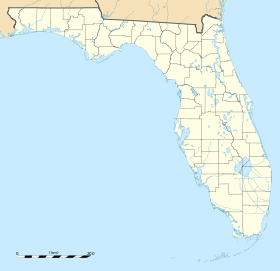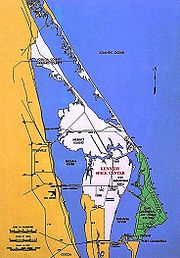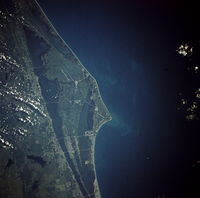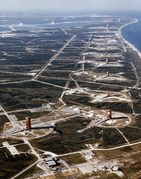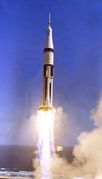Cape Canaveral Air Force Station
Cape Canaveral Air Force Station (CCAFS) is an installation of the United States Air Force Space Command's 45th Space Wing,[3] headquartered at nearby Patrick Air Force Base. Located on Cape Canaveral in the state of Florida, CCAFS is the primary launch head of America's Eastern Range[5] with four launch pads currently active. The facility is south-southeast of NASA's Kennedy Space Center on adjacent Merritt Island, with the two linked by bridges and causeways. The Cape Canaveral AFS Skid Strip provides a 10,000 foot runway[6] close to the launch complexes for military airlift aircraft delivering heavy and outsized payloads to the Cape.
The installation began as the Joint Long Range Proving Ground. Several major American space exploration "firsts" were launched from CCAFS, including the first U.S. earth satellite (1958), first U.S. astronaut (1961), first U.S. astronaut in orbit (1962), first two-man U.S. spacecraft (1964), first U.S. unmanned lunar landing (1966), and first three-man U.S. spacecraft (1967). It was also the launch site for the first spacecraft to ever fly past the other planets in the Solar System (1962–1977), and the first spacecraft to orbit Mars (1971) and roam its surface (1996).
History
The CCAFS area had been used by the United States government since 1949 when President Harry S. Truman established the Joint Long Range Proving Grounds at Cape Canaveral to test missiles. The location was among the best in the continental United States for this purpose as it allowed for launches out over the Atlantic Ocean, and it was closer to the equator than most other parts of the United States, allowing rockets to get a boost from the Earth's rotation.
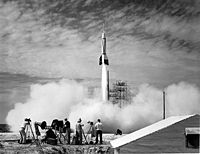
A Bumper V-2 was the first missile launched at Cape Canaveral on July 24, 1950.
On June 1, 1948, the U.S. Navy transferred the former Naval Air Station Banana River to the U.S. Air Force, with USAF renaming the facility the Joint Long Range Proving Ground (JLRPG) Base on June 10, 1949. On October 1, 1949, the Joint Long Range Proving Ground Base was transferred from the Air Materiel Command to the Air Force Division of the Joint Long Range Proving Ground. On May 17, 1950, the base was renamed the Long Range Proving Ground Base, but three months later was renamed Patrick Air Force Base, in honor of Army Maj. Gen. Mason Patrick.[7] In 1951, the Air Force established the Air Force Missile Test Center.
Early American sub-orbital rocket flights were achieved at Cape Canaveral in 1956.[8] These flights were shortly after some sub-orbital flights at White Sands, like Viking 11 on May 24, 1954. [9] Following the Soviet Union's successful Sputnik 1, the US attempted its first launch of an artificial satellite from Cape Canaveral on December 6, 1957. However, the rocket carrying Vanguard TV3 blew up on the launch pad.
NASA was founded in 1958, and Air Force crews launched missiles for NASA from CCAFS. Redstone, Jupiter, Pershing, Polaris, Thor, Atlas, Titan and Minuteman missiles were all tested from the site, the Thor becoming the basis for the expendable launch vehicle (ELV) Delta rocket, which launched Telstar 1 in July 1962. The row of Titan (LC-15, 16, 19, 20) and Atlas (LC-11, 12, 13, 14) launch pads along the coast came to be known as Missile Row in the 1960s. NASA's early manned spaceflights, Mercury and Gemini, were prepared for launch from Cape Canaveral Air Force Station launch pads LC-5, LC-14 and LC-19 by U.S. Air Force crews.
The Air Force chose to expand the capabilities of the Titan launch vehicles for its heavy lift capabilities. The Air Force constructed Launch Complexes 40 and 41 to launch Titan III and Titan IV rockets just south of Kennedy Space Center. A Titan III has about the same payload capacity as the Saturn IB at a considerable cost savings. Launch Complex 40 and 41 have been used to launch defense reconnaissance, communications and weather satellites and NASA planetary missions. The Air Force also planned to launch two Air Force manned space projects from LC 40 and 41. They were the Dyna-Soar, a manned orbital rocket plane (canceled in 1963) and the USAF Manned Orbital Laboratory (MOL), a manned reconnaissance space station (canceled in 1969).
From 1974-1977 the powerful Titan-Centaur became the new heavy lift vehicle for NASA, launching the Viking and Voyager series of spacecraft from Launch Complex 41. Complex 41 later became the launch site for the most powerful unmanned U.S. rocket, the Titan IV, developed by the Air Force.
Facilities
Of the many launch complexes built since 1950, only four remain active with two planned for future use. Launch Complex SLC-17 is the home of the Delta II.[10] Launch Complexes SLC-37 and SLC-41 have now been modified to launch EELV Delta IV and Atlas V launch vehicles, respectively.[11] These new launch vehicles will replace all earlier Delta, Atlas, and Titan rockets. Launch Complex SLC-47 is used to launch weather sounding rockets. Launch Complex SLC-46 is reserved for future use by the Spaceport Florida Authority.[12] Launch Complex SLC-40 hosted the first launch of the SpaceX Falcon 9 in June 2010.[13]
In the case of low-inclination (geostationary) launches the location of the area at 28°27′N put it at a slight disadvantage against other launch facilities situated nearer the equator. The boost eastward from the Earth's rotation is about 405 m/s (about 900 miles per hour) at Cape Canaveral against about 465 m/s (1,035 miles per hour) at the European Guiana Space Centre in French Guiana.[14]
In the case of high-inclination (polar) launches the latitude does not matter, but the Cape Canaveral area is not suitable because inhabited areas underlie these trajectories; Vandenberg Air Force Base, Cape Canaveral's West coast counterpart, is used instead.
The Air Force Space & Missile Museum is located at LC-26.[15]
Gallery
|
|
|
Cape Canaveral Air Force Station (shown in dark green)
|
|
|
|
Cape Canaveral as seen from orbit
|
|
|
|
Looking north along Missile Row in the 1960s
|
|
|
|
Cape Canaveral lighthouse
|
|
|
Apollo 7/Saturn 1B launch in 1968 from LC-37
|
|
|
Titan III-E launches the Voyager space probe in 1977 from LC-41 |
|
See also
- List of Cape Canaveral and Merritt Island launch sites
References
- ↑ 1.0 1.1 "National Register of Historical Places — Florida (FL), Brevard County". National Register of Historic Places. National Park Service. September 23, 2007. http://www.nationalregisterofhistoricplaces.com/FL/Brevard/state.html.
- ↑ "Cape Canaveral Air Force Station". Florida Heritage Tourism Interactive Catalog. Florida's Office of Cultural and Historical Programs. September 23, 2007. http://www.flheritage.com/services/sites/fht/record_t.cfm?ID=74&type=c&index=5.
- ↑ 3.0 3.1 "Patrick Air Force Base — FAQ Topic". Patrick Air Force Base. http://www.patrick.af.mil/questions/topic.asp?id=664.
- ↑ Cape Canaveral Air Force Station at National Historic Landmarks Program.
- ↑ CAST 1999, p. 1-12.
- ↑ "World Aero Data: Cape Cnaveral AFS Skid Strip — XMR". http://worldaerodata.com/wad.cgi?id=US75885. Retrieved August 31, 2008.
- ↑ CAST 1999, p. 1-5.
- ↑ Cape Canaveral LC5
- ↑ Encyclopedia Astronautica
- ↑ CAST 1999, p. 1-26.
- ↑ CAST 1999, p. 1-31.
- ↑ CAST 1999, p. 1-35.
- ↑ SpaceX Corp (October 23, 2009). "Dragon/ Falcon 9 Update". SpaceX. http://www.spacex.com/updates.php. Retrieved November 10, 2009.
- ↑ ASP: Up, Up, and Away
- ↑ CAST 1999, pp. 1-29 to 1-30.
Sources
External links
 Air Force Space Command (AFSPC) Air Force Space Command (AFSPC) |
|
| Air Forces |
Fourteenth · Twenty-Fourth
|
 |
|
| Centers |
Space and Missile Systems Center · Space Innovation & Development Center · 614th Air and Space Operations Center · 624th Operations Center · Air Force Network Integration Center
|
|
| Bases |
Buckley · Los Angeles · Patrick · Peterson · Schriever · Thule · Vandenberg |
|
| Stations |
Cape Canaveral · Cape Cod · Cavalier · Cheyenne Mountain · Clear · Kaena Point · New Boston · Onizuka (closed)
|
|
| Wings |
|
Space
|
1st · 2d · 3d · 21st · 30th · 45th · 50th · 460th
|
|
|
Acquisition
|
Global Positioning Systems · Launch and Range Systems · Military Satellite Communications Systems · Space-Based Infrared Systems · Space Development and Test · Space Superiority Systems
|
|
|
Air Base
|
61st Air Base
|
|
|
Cyber
|
67 NWW · 688 IOW · 689 CCW
|
|
|
| Groups |
|
Combat Comm
|
3d · 5th · 38 EIG · 162d · 201st · 226th · 251st · 252d · 253d · 254th · 281st
|
|
|
Cyber
|
26 NOG · 690 NSG · 67 NWG · 318 IOG
|
|
|
| Squadrons |
|
Space Aggressor
|
26th (AFRC) • 527th (ACC)
|
|
|
Command and Control
|
1st • 2d • 3d • 4th • 55th Mobile • 119th • 153d • 222d • 721st Mobile
|
|
|
Space Communications
|
3d • 50th • 850th
|
|
|
Space Control
|
1st • 4th • 16th • 20th • 25th • 76th • 380th
|
|
|
Space Development
|
1st • 2d • 3d
|
|
|
Space Experimentation
|
3d
|
|
|
Space Launch
|
1st • 2d • 3d • 4th • 5th
|
|
|
Space Operations
|
1st • 2d • 3d • 4th • 5th • 6th • 7th • 8th • 9th • 19th • 21st • 22d • 23d • 111th • 148th • AFSPC Space Operations Squadron
|
|
|
Space Surveillance
|
1st • 3d • 5th
|
|
|
Space Test
|
1st Air and Space • 2d • 3d • 4th
|
|
|
Space Weather
|
55th
|
|
|
Space Warning
|
2d • 4th • 5th • 6th • 7th • 8th • 9th • 10th • 11th • 12th • 13th • 137th • 213th
|
|
|
|
Cape Canaveral and Merritt Island launch sites |
|
|
|
|
LC-1 • LC-2 • LC-3 • LC-4 • LC-5 • LC-6 • LC-9 • LC-10 • LC-11 • LC-12 • LC-13 • LC-14 • LC-15 • LC-16 • SLC-17 • LC-18 • LC-19 • LC-20 • LC-21 • LC-22 • LC-25 • LC-26 • LC-29 • LC-30 • LC-31 • LC-32 • LC-34 • LC-36 • SLC-37 • LC-39 • SLC-40 • SLC-41 • LC-43 • LC-45 • LC-46 • LC-47 |
|
|
Atlantic Missile Range drop zone • Grand Turk Island drop zone • Mobile Launch Area • SLBM Launch Area • Patrick AFB • Shuttle Landing Facility • Cape Canaveral AFS Skid Strip
|
|
|
Spaceports |
|
Asia and the
Middle East |
|
|
| Europe |
|
|
| North America |
|
|
| South America |
|
|
| Pacific |
 DoD: Reagan Test Site (Kwajalein, Marshall Islands) · Private: Sea Launch DoD: Reagan Test Site (Kwajalein, Marshall Islands) · Private: Sea Launch
|
|
